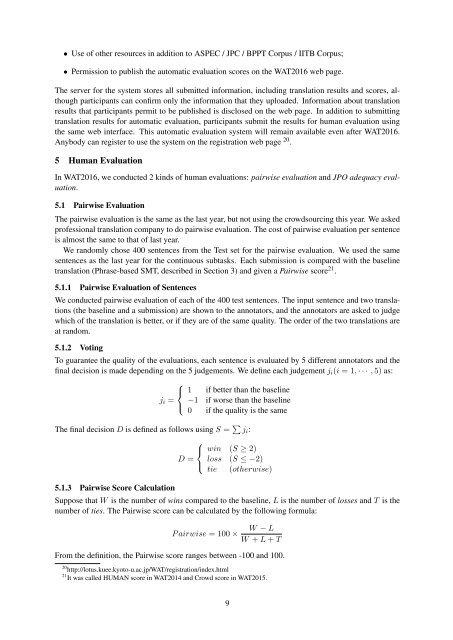December 11-16 2016 Osaka Japan
W16-46
W16-46
You also want an ePaper? Increase the reach of your titles
YUMPU automatically turns print PDFs into web optimized ePapers that Google loves.
• Use of other resources in addition to ASPEC / JPC / BPPT Corpus / IITB Corpus;<br />
• Permission to publish the automatic evaluation scores on the WAT20<strong>16</strong> web page.<br />
The server for the system stores all submitted information, including translation results and scores, although<br />
participants can confirm only the information that they uploaded. Information about translation<br />
results that participants permit to be published is disclosed on the web page. In addition to submitting<br />
translation results for automatic evaluation, participants submit the results for human evaluation using<br />
the same web interface. This automatic evaluation system will remain available even after WAT20<strong>16</strong>.<br />
Anybody can register to use the system on the registration web page 20 .<br />
5 Human Evaluation<br />
In WAT20<strong>16</strong>, we conducted 2 kinds of human evaluations: pairwise evaluation and JPO adequacy evaluation.<br />
5.1 Pairwise Evaluation<br />
The pairwise evaluation is the same as the last year, but not using the crowdsourcing this year. We asked<br />
professional translation company to do pairwise evaluation. The cost of pairwise evaluation per sentence<br />
is almost the same to that of last year.<br />
We randomly chose 400 sentences from the Test set for the pairwise evaluation. We used the same<br />
sentences as the last year for the continuous subtasks. Each submission is compared with the baseline<br />
translation (Phrase-based SMT, described in Section 3) and given a Pairwise score 21 .<br />
5.1.1 Pairwise Evaluation of Sentences<br />
We conducted pairwise evaluation of each of the 400 test sentences. The input sentence and two translations<br />
(the baseline and a submission) are shown to the annotators, and the annotators are asked to judge<br />
which of the translation is better, or if they are of the same quality. The order of the two translations are<br />
at random.<br />
5.1.2 Voting<br />
To guarantee the quality of the evaluations, each sentence is evaluated by 5 different annotators and the<br />
final decision is made depending on the 5 judgements. We define each judgement j i (i = 1, · · · , 5) as:<br />
⎧<br />
⎨ 1 if better than the baseline<br />
j i = −1 if worse than the baseline<br />
⎩<br />
0 if the quality is the same<br />
The final decision D is defined as follows using S = ∑ j i :<br />
5.1.3 Pairwise Score Calculation<br />
⎧<br />
⎨ win (S ≥ 2)<br />
D = loss (S ≤ −2)<br />
⎩<br />
tie (otherwise)<br />
Suppose that W is the number of wins compared to the baseline, L is the number of losses and T is the<br />
number of ties. The Pairwise score can be calculated by the following formula:<br />
P airwise = 100 ×<br />
W − L<br />
W + L + T<br />
From the definition, the Pairwise score ranges between -100 and 100.<br />
20 http://lotus.kuee.kyoto-u.ac.jp/WAT/registration/index.html<br />
21 It was called HUMAN score in WAT2014 and Crowd score in WAT2015.<br />
9



